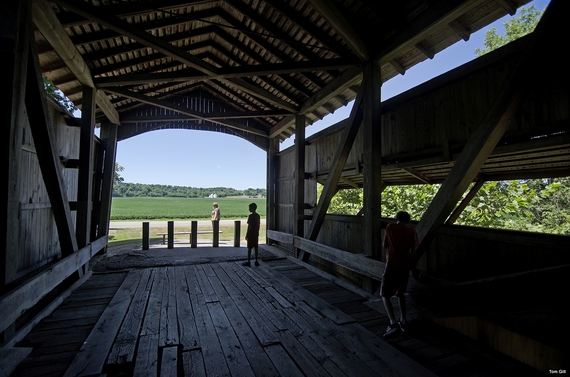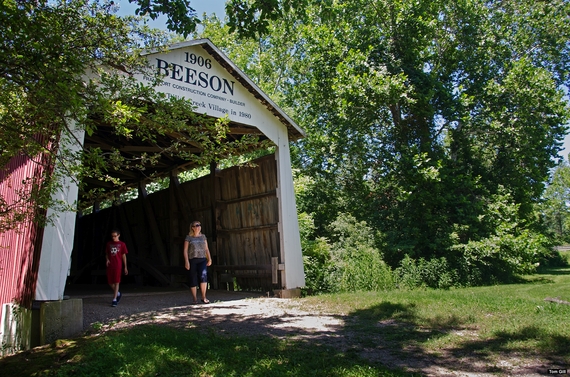
Located in the west-central portion of Indiana, just north of Terre Haute, lies Parke County, known as the "Covered Bridge Capital of the World." Thirty-one Covered bridges remain standing in the County, many of which still carry vehicular traffic. Compare that to Madison County, Iowa (made famous by the 1995 film The Bridges of Madison County), which only boasts six covered bridges.
At 263 foot long, the Roseville Covered Bridge replaced two previous bridges built across Big Raccoon Creek at this site. In 1910, the old bridge burned and a concrete bridge was considered as a replacement. Instead, the Roseville covered bridge was constructed, and remains today. Not far away in Armiesburg, a concrete bridge was built back in 1917 to replace the old bridge. It proved inferior to the traditional wooden bridge after only 13 years - it collapsed into the water!
In keeping with the construction of the time, and of the particular builder, the bridge uses two Burr Arch spans to cross the creek, and has a cut sandstone foundation. It is located on a gravel road, in an out-of-the-way portion of Parke County, very easy to miss while driving on adjacent Coxville Road. The local people seem to care for this bridge - an assortment of colorful flowers grows near the entrance.
Six miles southeast of Rockville, Indiana, stands the Neet Covered Bridge, said to be the last covered bridge built by Joseph Daniels, a well-known local bridge contractor. The 126 foot long bridge has spanned Little Raccoon Creek since 1904.
Windows were often built into these structures when the road curved near the bridge. The windows allowed persons crossing to view any traffic approaching the bridge from the road ahead. This explains why windows were often only on one side of the bridge, and sometimes only on one end. Closed to vehicular traffic today, the Neet Covered Bridge makes the perfect little rest stop when driving or biking this lonely section of Bridgeton Road. While resting, visitors can enjoy the historic bridge and the beautiful views of the countryside.
Originally built in 1906 across Big Raccoon Creek, the Beeson Covered Bridge was rescued and moved to its current location over Williams Creek. The bridge is no longer open to vehicular traffic, but serves as the entrance to Billie Creek Village, a collection of historical buildings including a general store, log cabin, church, and print shop
The Beeson bridge is a single Burr Arch spanning 55 feet. Named after the family whose farm was located near the bridge, the Beeson covered bridge was reunited with the family log cabin when it was moved to Billie Creek Village in 1979.
Carrying traffic over Mill Creek, the Bowsher Ford covered bridge celebrates her 101st birthday this year. Built in 1915 by Eugene Britton, the bridge resides on a gravel road about two miles northwest of Tangier, in rural Parke County, Indiana. A single Burr Arch span of 75 feet, this covered bridge differs a bit from most in Parke County, as it has a concrete foundation instead of cut stone.
Named after the Bowsher family who owned the farm near the ford (a shallow spot on the creek used for crossing), the bridge remains in a remote part of the county, surrounded by woods and farms, and is listed in the National Register of Historic Places.
Parke County, Indiana hosts the Covered Bridge Festival, a celebration of the 31 remaining covered bridges throughout the county. The festival begins each year, usually on the second Friday of October, and runs for nine days. What began as a small gathering back in 1956 has grown into a county-wide festival attracting over two million visitors to the county each year.
For the other 51 weeks of the year, it seems most of the covered bridges in Parke County remain quiet and isolated in their rural surroundings.
More of the bridges of Parke County in Part 2 coming soon.





